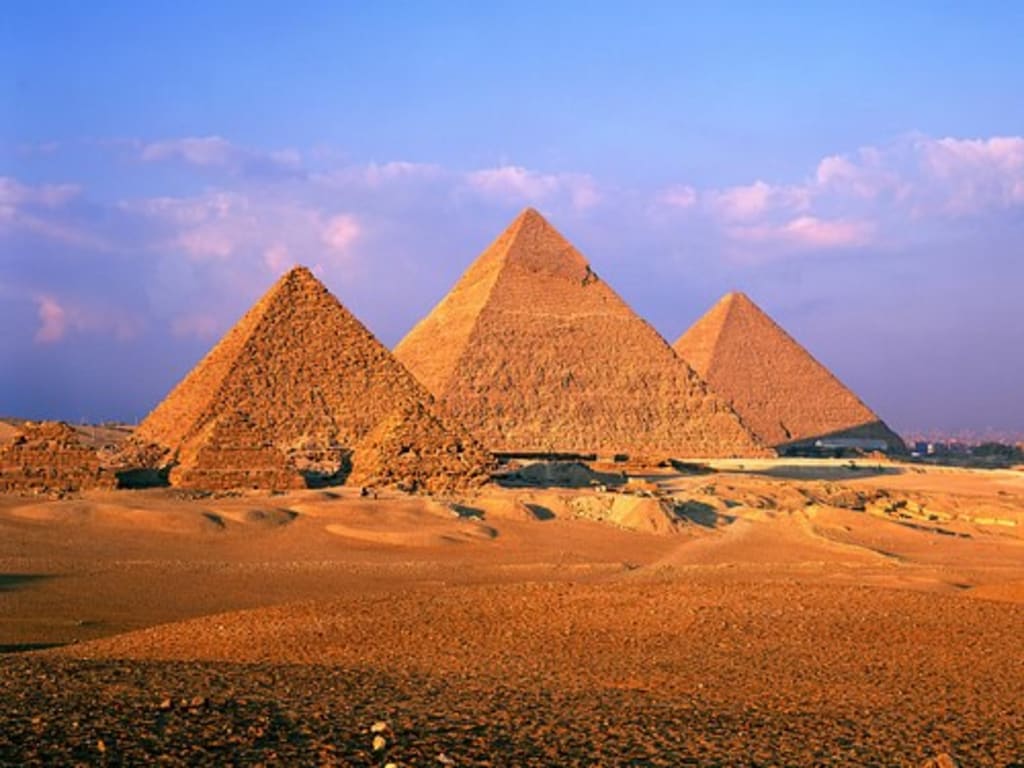
Ancient Egypt was a civilization of ancient Northeast Africa, concentrated along the lower reaches of the Nile River, situated in the place that is now the country Egypt. Ancient Egyptian civilization followed prehistoric Egypt and coalesced around 3100 BC (according to conventional Egyptian chronology)[1] with the political unification of Upper and Lower Egypt under Menes (often identified with Narmer).[2] The history of ancient Egypt occurred as a series of stable kingdoms, separated by periods of relative instability known as Intermediate Periods: the Old Kingdom of the Early Bronze Age, the Middle Kingdom of the Middle Bronze Age and the New Kingdom of the Late Bronze AgeEgypt reached the pinnacle of its power during the New Kingdom, ruling much of Nubia and a sizable portion of the Levant, after which it entered a period of slow decline. During the course of its history, Egypt was invaded or conquered by a number of foreign powers, including the Hyksos, the Nubians, the Assyrians, the Achaemenid Persians, and the Macedonians under Alexander the Great. The Greek Ptolemaic Kingdom, formed in the aftermath of Alexander's death, ruled Egypt until 30 BC, when, under Cleopatra, it fell to the Roman Empire and became a Roman province.[3] Egypt remained under Roman control until the 640s AD, when it was conquered by the Rashidun Caliphate.The success of ancient Egyptian civilization came partly from its ability to adapt to the conditions of the Nile River valley for agriculture. The predictable flooding and controlled irrigation of the fertile valley produced surplus crops, which supported a more dense population, and social development and culture. With resources to spare, the administration sponsored mineral exploitation of the valley and surrounding desert regions, the early development of an independent writing system, the organization of collective construction and agricultural projects, trade with surrounding regions, and a military intended to assert Egyptian dominance. Motivating and organizing these activities was a bureaucracy of elite scribes, religious leaders, and administrators under the control of a pharaoh, who ensured the cooperation and unity of the Egyptian people in the context of an elaborate system of religiousThe many achievements of the ancient Egyptians include the quarrying, surveying, and construction techniques that supported the building of monumental pyramids, temples, and obelisks; a system of mathematics, a practical and effective system of medicine, irrigation systems, and agricultural production techniques, the first known planked boats,[5] Egyptian faience and glass technology, new forms of literature, and the earliest known peace treaty, made with the Hittites.[6] Ancient Egypt has left a lasting legacy. Its art and architecture were widely copied, and its antiquities were carried off to far corners of the world. Its monumental ruins have inspired the imaginations of travelers and writers for millennia. A newfound respect for antiquities and excavations in the early modern period by Europeans and Egyptians has led to the scientific investigation of Egyptian civilization and a greater appreciation of its cultural legacy.[HistoryThe Nile has been the lifeline of its region for much of human history.[8] The fertile floodplain of the Nile gave humans the opportunity to develop a settled agricultural economy and a more sophisticated, centralized society that became a cornerstone in the history of human civilization.[9] Nomadic modern human hunter-gatherers began living in the Nile valley through the end of the Middle Pleistocene some 120,000 years ago. By the late Paleolithic period, the arid climate of Northern Africa had become increasingly hot and dry, forcing the populations of the area to concentrate along the river region.Predynastic periodPredynastic and Early Dynastic times, the Egyptian climate was much less arid than it is today. Large regions of Egypt were covered in treed savanna and traversed by herds of grazing ungulates. Foliage and fauna were far more prolific in all environs, and the Nile region supported large populations of waterfowl. Hunting would have been common for Egyptians, and this is also the period when many animals were first domesticated.[10]
By about 5500 BC, small tribes living in the Nile valley had developed into a series of cultures demonstrating firm control of agriculture and animal husbandry, and identifiable by their pottery and personal items, such as combs, bracelets, and beads. The largest of these early cultures in upper (Southern) Egypt was the Badarian culture, which probably originated in the Western Desert; it was known for its high-quality ceramics, stone tools, and its use of copper.[11]
The Badari was followed by the Naqada culture: the Naqada I (Amratian), the Naqada II (Gerzeh), and Naqada III (Semainean).[12] These brought a number of technological improvements. As early as the Naqada I Period, predynastic Egyptians imported obsidian from Ethiopia, used to shape blades and other objects from flakes.[13][14] Mutual trade with the Levant was established during Naqada II (c. 3600–3350 BC); this period was also the beginning of trade with Mesopotamia, which continued into the early dynastic period and beyond.[15] Over a period of about 1,000 years, the Naqada culture developed from a few small farming communities into a powerful civilization whose leaders were in complete control of the people and resources of the Nile valley.[16] Establishing a power center at Nekhen (in Greek, Hierakonpolis), and later at Abydos, Naqada III leaders expanded their control of Egypt northwards along the Nile.[17] They also traded with Nubia to the south, the oases of the western desert to the west, and the cultures of the eastern Mediterranean and Near East to the east.[18LanguageThe Egyptian language is a northern Afro-Asiatic language closely related to the Berber and Semitic languages.[111] It has the longest known history of any language having been written from c. 3200 BC to the Middle Ages and remaining as a spoken language for longer. The phases of ancient Egyptian are Old Egyptian, Middle Egyptian (Classical Egyptian), Late Egyptian, Demotic and Coptic.[112] Egyptian writings do not show dialect differences before Coptic, but it was probably spoken in regional dialects around Memphis and later Thebes.[113]
Ancient Egyptian was a synthetic language, but it became more analytic later on. Late Egyptian developed prefixal definite and indefinite articles, which replaced the older inflectional suffixes. There was a change from the older verb–subject–object word order to subject–verb–object.[114] The Egyptian hieroglyphic, hieratic, and demotic scripts were eventually replaced by the more phonetic Coptic alphabet. Coptic is still used in the liturgy of the Egyptian Orthodox Church, and traces of it are found in modern Egyptian Arabic.[115]TechnologyIn technology, medicine, and mathematics, ancient Egypt achieved a relatively high standard of productivity and sophistication. Traditional empiricism, as evidenced by the Edwin Smith and Ebers papyri (c. 1600 BC), is first credited to Egypt. The Egyptians created their own alphabet and decimal system.
Faience and glass
Even before the Old Kingdom, the ancient Egyptians had developed a glassy material known as faience, which they treated as a type of artificial semi-precious stone. Faience is a non-clay ceramic made of silica, small amounts of lime and soda, and a colorant, typically copper.[171] The material was used to make beads, tiles, figurines, and small wares. Several methods can be used to create faience, but typically production involved application of the powdered materials in the form of a paste over a clay core, which was then fired. By a related technique, the ancient Egyptians produced a pigment known as Egyptian blue, also called blue frit, which is produced by fusing (or sintering) silica, copper, lime, and an alkali such as natron. The product can be ground up and used as a pigment.[172]
The ancient Egyptians could fabricate a wide variety of objects from glass with great skill, but it is not clear whether they developed the process independently.[173] It is also unclear whether they made their own raw glass or merely imported pre-made ingots, which they melted and finished. However, they did have technical expertise in making objects, as well as adding trace elements to control the color of the finished glass. A range of colors could be produced, including yellow, red, green, blue, purple, and white, and the glass could be made either transparent or opaque.[174]
Medicine
Main article: Ancient Egyptian medicine
The medical problems of the ancient Egyptians stemmed directly from their environment. Living and working close to the Nile brought hazards from malaria and debilitating schistosomiasis parasites, which caused liver and intestinal damage. Dangerous wildlife such as crocodiles and hippos were also a common threat. The lifelong labors of farming and building put stress on the spine and joints, and traumatic injuries from construction and warfare all took a significant toll on the body. The grit and sand from stone-ground flour abraded teeth, leaving them susceptible to abscesses (though caries were rare).[175]
About the Creator
Reader insights
Outstanding
Excellent work. Looking forward to reading more!
Top insights
Compelling and original writing
Creative use of language & vocab
Easy to read and follow
Well-structured & engaging content
Excellent storytelling
Original narrative & well developed characters
On-point and relevant
Writing reflected the title & theme





Comments
There are no comments for this story
Be the first to respond and start the conversation.